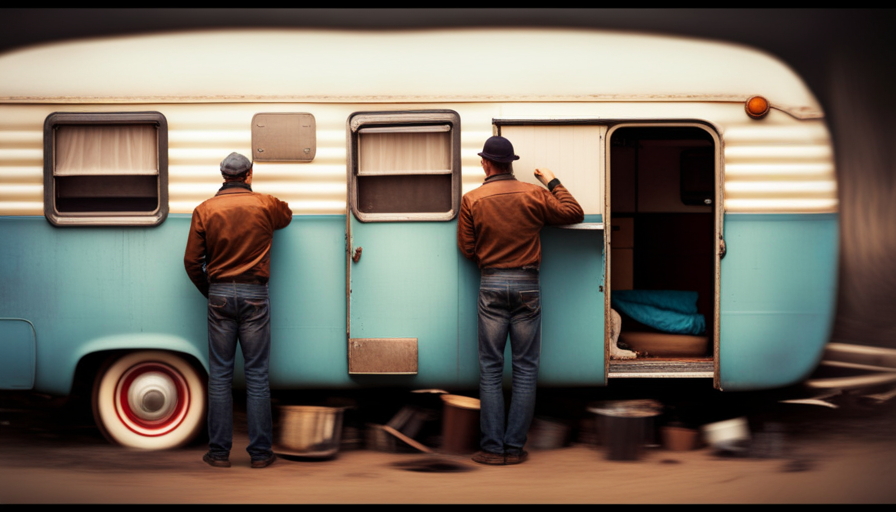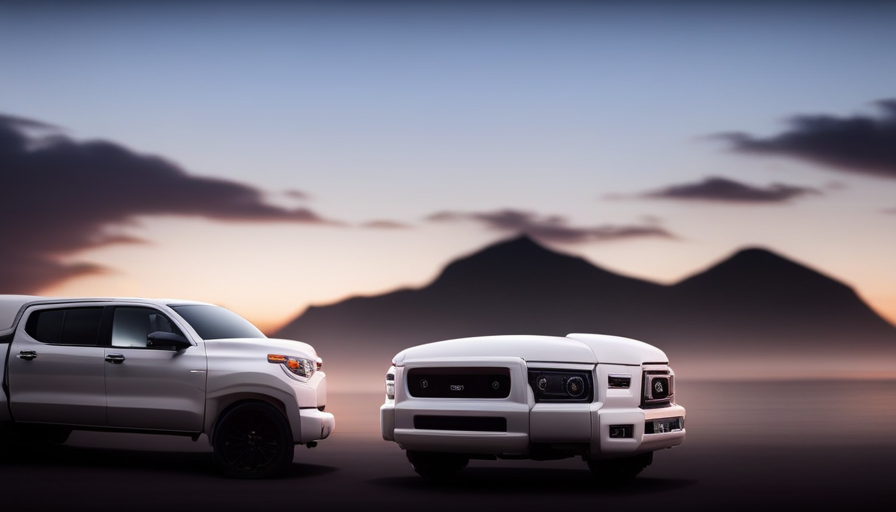Are you in the market for a used camper?
Picture this: you’ve saved up for years and finally found the perfect camper online. It seems like a dream come true – spacious, well-equipped, and at a price that won’t break the bank. But before you hand over your hard-earned money, there are some important questions you need to ask. Trust us, you don’t want to find yourself stuck with a lemon on your hands.
Let’s take a look at Sarah’s story.
Sarah was thrilled when she stumbled upon a used camper that seemed too good to be true. It was in great condition, had all the amenities she wanted, and was within her budget. However, after purchasing it, she quickly realized that she had overlooked some crucial details. The camper had a hidden water leak, the tires were worn out, and the suspension was shot. Sarah’s dream of hitting the open road turned into a costly nightmare.
To avoid a situation like Sarah’s, we have compiled a list of questions you need to ask when buying a used camper. By following these steps, you can ensure that your camper-buying experience is smooth, stress-free, and most importantly, leaves you with a camper that meets your needs and is in great condition.
Key Takeaways
- Determine budget and specific needs before shopping for a used camper.
- Research different types of campers that fit your needs and budget.
- Thoroughly inspect the exterior and interior of the camper for any signs of damage or wear and tear.
- Test all appliances, systems, and components of the camper before making a purchase.
Determine Your Budget and Needs
Before you start shopping for a used camper, it’s important to determine your budget and what you need in terms of size, amenities, and features.
Determining your budget will help you narrow down your options and ensure that you’re not overspending. Consider how much you’re willing to spend on the initial purchase as well as any additional costs such as repairs or upgrades.
Assessing your needs is equally important. Think about how many people will be using the camper and the amount of space you require. Consider the amenities and features that are important to you, such as a bathroom, kitchen, or air conditioning.
Additionally, think about the type of camping you’ll be doing and whether you need a camper that can handle off-road or rough terrain.
By determining your budget and assessing your needs, you can make a more informed decision when purchasing a used camper. Once you have a clear understanding of what you’re looking for, you can research different types of campers and find one that meets your criteria.
Research Different Types of Campers
Explore various types of campers that suit your needs and budget, so you can envision the perfect getaway and make unforgettable memories.
When researching different types of campers, it’s important to consider the benefits of each option. For example, pop-up campers are a popular choice due to their affordability and easy towing capabilities. They provide a comfortable sleeping area and often have a small kitchenette.
On the other hand, travel trailers offer more space and amenities, such as a bathroom and full kitchen. They’re ideal for longer trips and can accommodate larger groups.
Motorhomes are another option to consider, offering the convenience of a home on wheels. They come in various sizes and can be a great choice for those who want the freedom to travel without the need for towing.
As you research, take note of popular brands known for their reliability and quality craftsmanship. This will help you narrow down your options and make an informed decision.
As you explore the different types of campers and their benefits, you’ll be better prepared to inspect the exterior and interior of the camper, ensuring that it meets your standards and preferences.
Inspect the Exterior and Interior of the Camper
Take a walk around the camper and marvel at its sleek exterior, imagining the adventures you’ll have as you inspect the shiny paint job and sturdy construction. Buying a used camper has its pros and cons. On the one hand, it can be a more affordable option, allowing you to enjoy the RV lifestyle without breaking the bank. On the other hand, there may be some common issues to look out for in a used camper.
Here are a few things to keep in mind as you inspect the exterior and interior:
- Check for any signs of water damage, such as soft spots on the walls or ceiling, as this could indicate a leaky roof or plumbing issues.
- Look for any signs of rust or corrosion on the exterior, especially around the wheel wells and hitch, as this could be a sign of poor maintenance or exposure to harsh weather conditions.
- Inspect the tires for any signs of wear or dry rot, as replacing them can be costly.
- Examine the interior for any signs of wear and tear, such as stained upholstery or damaged cabinets.
As you finish inspecting the camper, it’s important to ask about the camper’s maintenance history. This will give you insight into how well the previous owner took care of the vehicle and whether any major repairs have been done.
Ask About the Camper’s Maintenance History
Make sure to inquire about the maintenance history of the camper to get a clear understanding of how well it’s been taken care of. Asking for the camper’s maintenance records is essential to determine if the previous owner has followed a regular maintenance schedule. These records will provide valuable insight into the history of the camper’s maintenance, including any repairs, services, or replacements that have been done over time.
By examining the maintenance records, you can identify any potential issues or recurring problems that may have occurred in the past. It’s important to look for consistency in the maintenance schedule, as regular servicing indicates responsible ownership and proper care of the camper. Additionally, these records will give you an idea of the overall condition of the camper and whether it’s received the necessary attention to keep it in optimal working condition.
Once you’ve reviewed the maintenance history, you can then inquire about any previous accidents or damage that the camper may have experienced. Understanding the maintenance and repair history will help you assess the overall reliability and longevity of the camper.
Transitioning into the next section, it’s crucial to investigate any previous accidents or damage to ensure you have a complete picture of the camper’s past.
Inquire About Any Previous Accidents or Damage
Ensure you fully understand the history of the camper by delving into any previous accidents or damage it may have encountered. This will give you a better understanding of the overall condition of the camper and help you make an informed decision before purchasing.
Here are some important questions to ask regarding the previous accident history and damage history:
-
Has the camper ever been in an accident? If so, what was the extent of the damage and how was it repaired?
-
Are there any records or documentation of previous accidents or repairs?
-
Has the camper ever had any water damage or leaks? If so, how were they addressed and repaired?
-
Are there any signs of structural damage or issues that could affect the integrity of the camper?
By asking these questions, you can gain insight into any potential issues that may have been previously encountered by the camper. This information will help you determine if the camper is in good condition or if there may be underlying problems that need to be addressed.
After understanding the previous accident and damage history, you can then move on to testing the camper’s appliances and systems to ensure they’re in proper working order.
Test the Camper’s Appliances and Systems
Once you’ve thoroughly examined the camper’s accident and damage history, it’s crucial to assess the functionality and performance of its appliances and systems to ensure a smooth and enjoyable camping experience. Testing the appliances and checking the systems will give you a clear understanding of their condition and help you avoid any surprises down the road.
Start by testing the refrigerator. Turn it on and give it some time to cool down. Check if it reaches the desired temperature and maintains it consistently. Additionally, make sure the freezer compartment is functioning properly.
Next, test the stove and oven. Ignite the burners and ensure they light up quickly and evenly. Try baking something in the oven to see if it heats up properly. Don’t forget to also check the microwave, ensuring it heats food evenly and the buttons are responsive.
Moving on to the camper’s systems, begin by testing the water pump and plumbing. Turn on the faucets and check for any leaks or irregular water flow. Flush the toilet and observe if it operates smoothly. Test the heating and cooling systems, ensuring they provide the desired temperature and proper air circulation.
Finally, check the camper’s electrical system, including the lights, outlets, and any other electrical components.
By thoroughly testing the appliances and checking the systems, you can ensure they’re in good working condition before making your purchase. Once you’ve completed this step, it’s time to move on to the next section about checking the camper’s tires and suspension.
Check the Camper’s Tires and Suspension
As you venture into the realm of checking the camper’s tires and suspension, tread carefully to uncover any hidden signs of wear and tear that may impact your future camping adventures. The condition of the tires is crucial for a safe and smooth ride, so be sure to inspect them thoroughly.
Look for any signs of uneven wear, such as bald spots or bulges, as these could indicate alignment issues or potential tire blowouts. Additionally, check the tire tread depth using a tread depth gauge to ensure they meet the minimum legal requirements.
Next, shift your focus to the suspension quality. Examine the suspension components, such as the leaf springs, shocks, and bushings. Look for signs of rust, corrosion, or damage, as these can affect the camper’s stability and overall performance on the road. Pay attention to any unusual noises or vibrations when test driving the camper, as they could indicate suspension problems.
Now that you have assessed the tire condition and suspension quality, you can proceed with confidence knowing that your camper is roadworthy and capable of handling your future adventures. But before you finalize the purchase, it’s essential to ask about the camper’s ownership history to ensure there are no hidden surprises awaiting you down the road.
Ask About the Camper’s Ownership History
Before you make a decision, it’s crucial to find out about the camper’s ownership history to avoid any unexpected surprises. Asking about the ownership history will provide valuable insights into how well the camper has been maintained and cared for over the years.
It’s important to inquire about the number of previous owners and the length of time each owner had the camper. This information can give you an idea of how much wear and tear the camper has endured.
Additionally, it’s essential to ask about the maintenance history of the camper. Find out if regular maintenance, such as oil changes, tire rotations, and brake inspections, has been performed. Knowing if the camper has had any major repairs or replacements can also help you assess its overall condition and potential future expenses.
Understanding the ownership history and maintenance of the camper will give you a clearer picture of its reliability and longevity. It will also help you determine if the asking price is reasonable based on the camper’s condition and maintenance records.
With the ownership history and maintenance information in hand, you can now move on to the next step: requesting a test drive or towing experience.
Request a Test Drive or Towing Experience
To fully experience the camper’s performance and handling, take it for a test drive or towing experience. This step is crucial when buying a used camper, as it gives you the opportunity to test how the camper handles on the road and ensures that it meets your needs and expectations.
Here are some benefits of test driving a used camper:
- You can get a feel for how the camper drives and handles different road conditions. This will help you determine if it’s comfortable and easy to maneuver.
- Test driving allows you to check the brakes, acceleration, and overall performance of the camper. You can assess if it meets your towing requirements and if it feels safe and reliable on the road.
- It gives you the chance to test the interior features and amenities, such as the air conditioning, heating, and entertainment systems. This will help you determine if everything’s in working order and if it meets your comfort needs.
In addition to test driving, it’s important to know some tips for towing a camper safely and effectively:
- Make sure your vehicle is capable of towing the weight of the camper. Check the manufacturer’s guidelines and consult with a professional if needed.
- Practice towing in a safe and open area before hitting the road. This will help you get familiar with the handling and braking differences when towing a camper.
- Be mindful of your speed and braking distance when towing. The added weight of the camper will affect your vehicle’s performance, so drive cautiously and allow for extra stopping distance.
Once you’ve completed the test drive or towing experience, it’s time to move on to the next step of buying a used camper: getting a professional inspection and considering financing options.
Get a Professional Inspection and Consider Financing Options
Now it’s time for us to discover the hidden secrets and potential pitfalls of the camper by getting a professional inspection and exploring financing options that could turn our dream into a reality.
A professional inspection is crucial when buying a used camper. Even if the camper looks great on the outside, there could be hidden issues that only an expert can uncover. A professional inspector will thoroughly examine the camper’s structure, electrical systems, plumbing, appliances, and overall condition. They’ll provide a detailed report, giving us an accurate assessment of any repairs or maintenance that may be needed.
When it comes to financing options, there are several routes to consider. Firstly, we can explore traditional financing through a bank or credit union. This option allows us to secure a loan and make monthly payments.
Another option is to consider financing through a dealership or camper loan specialist. These institutions may have specific loan programs tailored for RV purchases, offering competitive rates and terms.
Additionally, we can also explore personal loans or using a home equity line of credit if we have that option available to us.
It’s important to carefully consider our financing options and choose one that best suits our financial situation and long-term goals. By getting a professional inspection and exploring various financing options, we can ensure that we’re making an informed decision when purchasing a used camper.
Frequently Asked Questions
What is the average lifespan of a used camper?
The average lifespan of a used camper can vary depending on several factors, such as the brand, model, and overall maintenance. Generally, with proper care and maintenance, a camper can last anywhere from 10 to 20 years.
Regular maintenance requirements include checking for water leaks, inspecting the electrical system, and keeping up with routine maintenance tasks like tire rotations and oil changes. By addressing these maintenance needs, you can extend the lifespan of your used camper.
Are there any recalls or safety issues with this specific camper model?
Recall information and safety concerns are crucial when considering a specific camper model. It’s like diving into a clear blue lake, only to discover hidden rocks beneath the surface.
To ensure peace of mind, we recommend checking if there have been any recalls on the camper. Additionally, thoroughly inspect its safety features, such as brakes, tires, and electrical systems.
Don’t let potential hazards dampen your camping adventures. Stay informed and prioritize your safety.
Are there any hidden fees or additional costs associated with purchasing a used camper?
When buying a used camper, it’s essential to be aware of any hidden fees or additional costs that may arise. These can include registration fees, transfer fees, or even storage fees if you don’t have a place to keep it.
It’s crucial to ask the seller upfront about any potential expenses you may incur after purchasing the camper. By being proactive and informed, you can avoid any unexpected financial burdens and make a well-informed decision.
Can you provide the camper’s service records and documentation?
Sure, we understand the importance of having a complete service history and maintenance records when purchasing a used camper. These documents provide a clear picture of the camper’s past maintenance and any potential issues. It’s like having a roadmap to the camper’s health.
By reviewing these records, we can identify any major repairs or recurring problems. So, we always make sure to ask for the camper’s service records and documentation before making a purchase.
Are there any transferable warranties or extended service plans available for this camper?
Yes, there are transferable warranties and extended service plans available for this camper. These provide added protection and peace of mind for your purchase. The transferable warranties allow you to pass on the remaining coverage to a new owner if you decide to sell the camper in the future.
Additionally, the extended service plans offer extended coverage beyond the manufacturer’s warranty, ensuring that you’re covered for any unexpected repairs or maintenance.
What Are the Key Factors to Consider When Buying a Used Camper?
When searching for a used camper, it’s crucial to keep a few buying used camper tips in mind. Firstly, assess the condition of the camper thoroughly, paying close attention to any structural damage or maintenance issues. Secondly, consider your specific camping needs and prioritize key features accordingly. Lastly, don’t forget to check the camper’s history, including maintenance records and any previous accidents. By following these buying used camper tips, you can make an informed decision and find a reliable and suitable camper for your adventures.
What are important features to consider when purchasing a used camper for building teardrop camper plans?
When purchasing a used camper to build your own teardrop camper, important features to consider include the condition of the exterior and interior, the weight of the camper, and the compatibility with your teardrop camper plans. It’s also crucial to check for any water damage or structural issues before making a purchase.
Conclusion
In conclusion, buying a used camper can be a great option for those looking to enjoy the freedom of the open road without breaking the bank. By following these steps and asking the right questions, you can ensure that you make a smart and informed purchase.
Remember, knowledge is power, and it’s important to do your due diligence before making any decisions. So, don’t jump the gun, take your time, and you’ll be hitting the road in your perfect camper in no time. After all, as the saying goes, "Good things come to those who wait."










